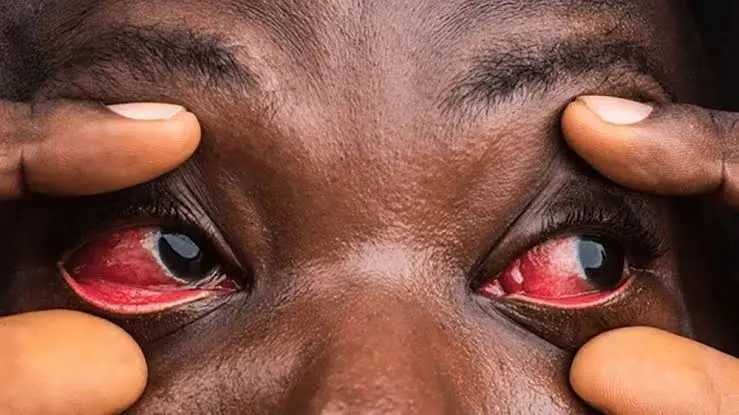Author's details
- Dr. Khashau Eleburuike
- MBBS (Ilorin) MSc. Global Health Karolinska Institute.
- Resident doctor in family medicine in Northern Sweden.
Reviewer's details
- Dr Odukanmi Oluronke
- B.SC, MBBS, MPH (Ilorin), Fellow West African College of Surgeon (Ophthalmology).
- Consultant Ophthalmologist, Kwara State Specialist Hospital; Alagbado.

- Date Published: 1741651200
- Date Updated: 1741651200
Red Eyes for Patients Adapted for Sub-Saharan Africa
Introduction
What Are Red Eyes?
Red eyes, also called “pink eyes,” refer to redness in the white part of the eyes. This condition can be caused by various factors, ranging from mild irritation to more serious infections or diseases. Red eyes are a common problem in sub-Saharan Africa due to environmental conditions and access to healthcare.
Discussion
Causes of Red Eyes
- Eye Infections: Bacterial or viral infections, like conjunctivitis (pink eye), are a common cause.
- Allergies: Dust, pollen, smoke, and other irritants can trigger red eyes, especially in regions with high pollution or dry seasons.
- Dry Eyes: Long exposure to wind, sun, or dry air can cause the eyes to become dry and red.
- Eye Injuries: Any trauma or foreign object in the eye can result in redness.
- Poor Hygiene: Sharing personal items like towels or using contaminated water can lead to infections that cause red eyes.
- Glaucoma or Uveitis: In some cases, red eyes can be a symptom of more serious eye conditions, requiring medical attention.
Symptoms of Red Eyes
- Redness in one or both eyes
- Itching or burning sensation
- Watery Eyes or discharge
- Swelling of the eyelids
- Sensitivity to Light
- Blurred Vision in severe cases
When to Seek Medical Help
- If the redness persists for more than a few days
- If you experience severe pain, blurred vision, or light sensitivity
- If there is thick yellow or green discharge
- If the red eyes are caused by an injury
- If you have a history of eye problems, like glaucoma
Treatment for Red Eyes
- Mild Cases: Resting your eyes, using clean water to gently wash them, and avoiding irritants may help. Cool compresses can reduce swelling.
- Infections: Depending on the type of infection, your healthcare provider may recommend antibiotic eye drops (for bacterial infections) or antiviral treatment (for viral infections).
- Allergies: Antihistamine drops or oral medication can help reduce redness caused by allergies.
- Avoid Self-Medication: Using unprescribed eye drops, traditional eye treatments, or other remedies may worsen the condition.
Prevention Tips
- Maintain Good Eye Hygiene: Avoid rubbing your eyes, wash hands regularly, and don’t share personal items like towels.
- Protect Your Eyes: Wear sunglasses to shield your eyes from dust, wind, and bright sunlight.
- Use Clean Water: Ensure you only use clean, safe water to wash your face and eyes.
- Avoid Smoke and Irritants: Stay away from smoky or dusty environments that can irritate your eyes.
Accessing Care in Sub-Saharan Africa
- Local Clinics and Pharmacies: Seek help from local health centers or pharmacies if you experience persistent or worsening red eyes.
- Outreach Programs: Some areas have health programs or eye clinics offering eye care services and screenings, particularly in rural regions.
- Avoid Harmful Practices: Traditional remedies, like applying herbs or harmful substances, can damage your eyes and should be avoided. Example of harmful substances is the use of urine to treat red eye which could sometimes leads to Gonococcal conjunctivitis.
Conclusion
Red eyes are common but often easily treatable. It’s important to maintain good eye hygiene and avoid irritants. If your symptoms don’t improve or if you experience severe symptoms, seek medical attention to prevent further complications. Proper care and prevention can help protect your eyes and vision.
References
- Ssentongo R, Alimwenda V. FACTORS ASSOCIATED WITH THE PREVALENCE OF ALLERGIC CONJUNCTIVITIS AMONG PATIENTS RECEIVING EYE CARE SERVICES IN JINJA REGIONAL REFERRAL HOSPITAL EYE CLINIC. A CROSS-SECTIONAL STUDY. SJ Ophthalmology Africa. 2024 Apr 8;1(4):9
- Schaftenaar E, van Gorp EC, Meenken C, Osterhaus AD, Remeijer L, Struthers HE, McIntyre JA, Baarsma GS, Verjans GM, Peters RP. Ocular infections in sub‐Saharan Africa in the context of high HIV prevalence. Tropical Medicine & International Health. 2014 Sep;19(9):1003-14.
- Azari AA, Barney NP. Conjunctivitis: a systematic review of diagnosis and treatment. Jama. 2013 Oct 23;310(16):1721-30.
- Alfonso SA, Fawley JD. Conjunctivitis. Primary care. 2015 Jul 29;42(3):325-45.
